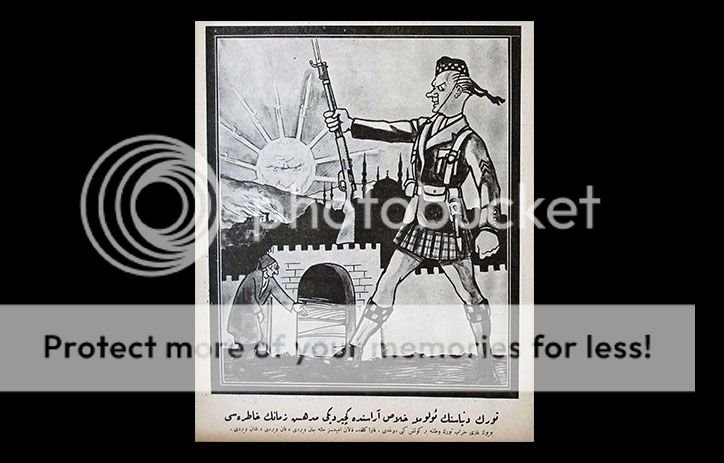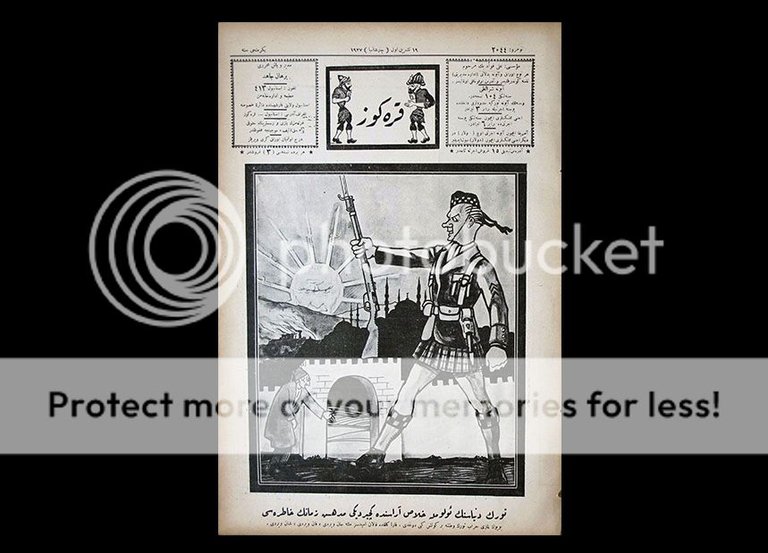
(Cartoon, Karagöz, 19 October 1927, no. 2044, page 1.)
Türkçe:
Türk dünyasının ölümle halas arasında geçirdiği müthiş zamanın hatırası.
Büyük Gazi harap Türk vatanına bir güneş gibi doğdu. Karanlıkta kalan ümitsiz millete can verdi, kan verdi, şan verdi.
English:
A souvenir of the devestating time the Turkish world experienced between death and salvation.
The great Gazi rose like the sun over the Turkish motherland. He gave life, blood, and glory to a hopeless nation that was left in the dark.
Comments
The present cartoon is layered in both meaning and imagery. The artist has projected a complex, albeit abridged, narrative weaving several years of events into one seamless composition. The imagery is straightforward and clearly legible to anyone in 1927 with a stronger memory than that of a goldfish. The cartoon, which covers the entire front page of the magazine (besides its masthead/nameplate), provides a visual summary of the post-WWI Allied occupation of Ottoman lands. It presents a bleak picture save for the large, luminous sun rising over the horizon, which indicates hope—foretelling a change that would swing the pendulum of fortune away from the occupying forces.
A colossal man thrusting a bayonet to the sky visually dominates the composition. He constitutes one of the many Turkish rendition of the classic John Bull character, who is a personification of the United Kingdom. Today in 1920s Turkey has witnessed a variety of John Bulls (see posts #50, #51, #76, and #84). Sometimes John Bull is represented wearing a scandalously short Scottish kilt by Turkish artists in order to effeminize and therefore insult British masculinity. As the most visible “enemy” in the composition the Englishman is shorthand for the Allied forces, especially the British presence in occupied Istanbul.
To be sure, Istanbul’s occupation was no laughing matter to the Istanbul-based press. Indeed, the entire cartoon is clearly set in Istanbul as it displays several visible monuments: two mosques dotting the silhouetted skyline and one of the gates at Istanbul’s walls situated somewhat in the foreground. In a sense, this gate is the beginning of the story of post-WWI occupation. Standing outside the gate is the last sultan, Mehmet VI (i.e., Vahdettin). He is depicted bending at the waist in a submissive pose with one hand held out and another hand tucking away his coat, as if to get it out of the way of the forward-marching John Bull. His specific gesture is familiar to any Turk: it reads buyurun! or “welcome!” from a mile away, essentially inviting John Bull to occupy Istanbul.
The final sultan was often framed in this way in the early Republican nationalist press. Like John Bull’s freakishly short kilt, it is an exaggeration or rather, outright falsity. Once the Allied occupation began across the Ottoman Empire the sultan was unable to act in any meaningful capacity because his capital city, Istanbul, was under very direct and suffocating occupation. This is why the nationalist War of Independence that followed was based in Anatolia and not Istanbul, the epicenter of occupation. Nevertheless, from 1920 to 1922 Turkey’s administration was bifurcated. War-related decisions and diplomatic negotiations were coming out of Ankara’s Grand National Assembly government while Istanbul’s sultanate remained an impotent, sitting duck. Thus, once the war was won, and a new state’s borders drawn, the sultanate was abolished by the nationalist government and the last sultan, Mehmet VI was required to leave the country’s soils aboard a British battleship in November of 1922. Unable to curate his own image from abroad, the final sultan’s impaired legacy was quickly transformed by the pro-Republican literati (and cartoonists!) into that of an internal enemy and traitor who collaborated with external foes. And the present image is one example of how such framing occurred.
The sun rising in the distance comprises the final piece of the puzzle. It bears the uncanny facial features of Turkey’s first President and war hero, “Gazi” Mustafa Kemal Pasha. As the leader of the nationalist resistance in Anatolia during occupation (1919-1922), Mustafa Kemal (Atatürk) was often represented in cartoons as the sole victory of the War of Independence, which is what we are seeing here. The bayonet rays emitting out from the solar orb render explicit this symbolic relationship. According to this cartoon, he was the sun that illuminated Turkey’s future and drove out the unwelcome guests.
So what is the occasion for publishing such a cartoon, you may ask? The most significant thing happening in Turkey at this moment in history is by far the delivery of President Mustafa Kemal Pasha’s landmark speech, Nutuk. What is often referred to as his “marathon speech,” the entire work, which was later published in book format, was delivered by the President himself at the opening of the second Republican People’s Party congress over the course of six days. Beginning on October 15, 1927 the President read his account the War of Independence in six-hour installments before congress, dignitaries, and members of the press. Newspapers reported on the event with daily updates summarizing the the previous day’s speech. This cartoon is likely inspired by content or sentiments expressed by the President in the days leading up to its publication.

(Entire page, Karagöz, 19 October 1927, no. 2044, page 1.)
a very good post, one of my paternal uncles (fathers brother) migrated to Turkey to participate in the war of independence, he died and is buried in Turkey .His name was Abdul Rehman Peshawari .
Wow, that's a high calling. Where did he migrate from? Do you know where he is buried?
He migrated from Peshawar, Pakistan and is buried in a grave yard near Intercontinental or Hilton hotel in Istambul.
That's fascinating! I'm familiar with that location. Have you had a chance to visit his grave ever? Was it common for people to leave Pakistan to fight in the Turkish War?
He was part of the
khilafat movement.I have not visited his grave but some of my family has, but we are planning to visit Turkey on our next holiday and another thing, this uncle of mine Abdul Rehman Peshawari was very close to the post War regime so much so that he was chosen as the Turkish ambassader to Afghanistan where he served for a couple of years.Is this him: https://en.wikipedia.org/wiki/Abdur_Rehman_Peshawri
Yes this is him !
Yes this is him !
Çok iyi paylaşım olmuş.
Bir de 1800lü yılların sonunda Fransa'da çıkan "La Revolution-Devrim (altbaşlık: organe de la democratie musulmane-demokrat müslümanların yayın organı)" dergisine bakmak lazım. Bu gibi örnekler epey var.
Bir imparatorluğun çöküşü ve bir ülkenin doğuşuna dair muazzam tartışmalara zemin hazırlamış bir dergi.
Referans için teşekkürler. Ondokuzuncu yüzyılda Avrupa’da yayınlanmış Osmanlıca dergilerden haberim vardı ama senin bahsettiğin yayını daha önce duymamıştım. Özellikle birinci Meşrutiyet’ten sonra sansürsüz fikir alışverişi yapmak isteyenler mecbur bunu Avrupa’dan yapmak zorunda kaldılar. La Revolution/İnkilab’ın dijitalleştirilmiş bir kolleksiyonunu biliyor musun?
too much good post
check my new post:
https://steemit.com/photography/@msazzad2/5aqjtr-mobile-photography
please follow and upvote if u like it...
Thanks.
ditto.
Congratulations @yasemin-gencer! You have completed some achievement on Steemit and have been rewarded with new badge(s) :
Click on any badge to view your own Board of Honor on SteemitBoard.
For more information about SteemitBoard, click here
If you no longer want to receive notifications, reply to this comment with the word
STOP